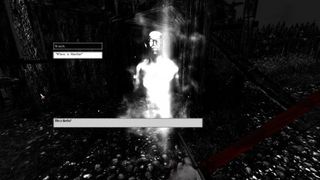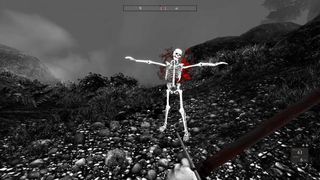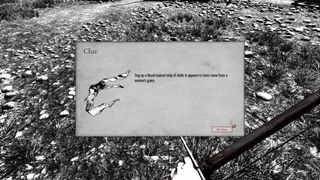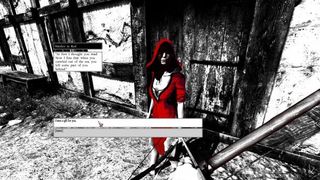Our Verdict
It starts promising and gets better in the final act, but the bulk of Betrayer's journey is let down by inconsistent quality, repeat enemies, and investigative drudgery.
PC Gamer's got your back
I wash ashore in 17th century America at the border of a desolated British colony. Water, sand, and forest are stark greyscale, shadows turned up to black and the sky washed of detail. Wind howls, then dies. I imagine it carries the scent of Virginia's fir trees on the back of a foreboding chill, and then I swipe my knife at a wooden crate, collapsing it with a cartoonish bonk on the side.
Betrayer is a first-person shooter which leans heavily on story and atmosphere, pillars that appear sturdy for a moment but start to crumble within minutes. Its ominous forest, dense and deeply shaded, hides a mysterious woman whose shawl bleeds red ink into the grey, promising an enigmatic adventure to come. But the first thing I do is goofily bash open a crate like Gordon Freeman, and the second thing I do is open a letter which summons a bland, placeholder-ey interface and mentions “enemies,” a word that sucks out atmosphere like an open airlock.
A few more minutes in and the gusts of wind begin to register as a looping sound effect, part of which carries the obvious distortion caused by wind battering a microphone. And the dead silence between gusts feels erroneous until it's explained as a stealth mechanic (use wind to mask your footsteps) that I'll never need or want to use. I also have to return to the main menu to turn off the ugly depth of field filter, which smudges distant trees like water spilled on charcoal.
The brave new otherworld

With that taken care of, Betrayer does look great. The lack of color lets it bear its teeth with texture; the competing noise of shiny rocks, coarse grass, and patterned bark is menacing and disorienting. The sound design is less consistent, but mostly succeeds. Musical stings are pleasing indicators of success and danger, and arrows satisfyingly thwap into the gaps in my tutorial enemy's armor. But I'm still concerned about the struggling sense of atmosphere when...
The ring of a bell smashes me into a dark otherworld, obscuring the sun with spectral dust. It's a great effect which is present throughout the game, and the first instance of belleportation is directly followed by more promising intrigue as I dig up petrified body parts which allow me to see and speak with ghosts.

I'm pulled back in for a moment, but within an hour the otherworld has become tedious, and everything I find to love about Betrayer from then on is separated by long stretches drudgery, broken up only moderately well by fights with demonic conquistadors and reanimated skeletons.
Betrayer's areas (each several acres of forest, cabins, and forts) come in mid-day sun and dark otherworld flavors. In the sunlight, demonic conquistadors patrol paths while camouflaged natives pop in and out of the woods to harass with arrows. The soldiers have, unlike many games with a stealth mechanic, eyes that work . I appreciate that they can spot me from over 100 yards away, triggering a clap of strings as they trundle at me with bows, muskets, and pistols.
Fights in the daylight are hard. Not Dark Souls hard, but hard. My most-used weapon is the longbow, because arrows can be recovered and reloading is lightning fast compared to the 17th-century one shot musket and pistol. Though I love the force of their discharge, and the painful tension of the meticulous reloading ritual—powder, ball, ramrod, come on come on come on —I only use guns when surrounded and bleeding health fast, or for certain enemies which can't be killed otherwise.

With the longbow, distance shots are tricky due to the arc of the arrows. I never quite became accustomed to the parabola, which feels a little unnatural. In closer quarters, chest shots are easy to score against the forward-moving baddies, but there's a chance arrows will glance off their armor, and even basic conquistadors take a few to put down.
After learning to strafe dodge enemy projectiles while releasing a stream of arrows, one to three enemies don't pose a major threat. And after a fight, you can fast travel to a fort to grab a sip of water—Betrayer's health restoration potion—and refill your waterskin for on-the-go healing, so the fallout of one battle rarely affects the next. But when four or more armored devils are bolting across a field, there's good reason to worry. With the default difficulty settings (recently patched to be adjustable), most of your loot drops at death and must be reclaimed without dying again.

I could have been stealthier, but the amount of exploring required makes death, even with its harsh penalty, preferable to crouching around in the grass and waiting for gusts of wind to mask my steps. And in the otherworld, stealth is wholly unnecessary because fights are mostly a cakewalk: skeletons are the primary enemy, and they fall to a few arrows or a couple melee attacks. The only challenging otherworld fights are unavoidable: corrupted totems which are cleansed by defeating a squad of skeletons and nasty floating skull monsters whose attacks can't be dodged. They only fall to guns and are awful.
Specter inspector
With just a handful of enemy types, fights are short on surprise and feel laborious after a couple hours (oh look, more skeletons!), but the conquistadors can generate some tense battles and work as an obstacle to progression. Combat aside, though, the act of progressing is laborious on its own. Rather than turning and running at the first sight of a demon-eyed Spaniard, I've oddly decided to investigate the colony's fate by chatting up ghosts and investigating their deaths.
I find a bloody mess on the ground, and I look at it, and then I dig up a trinket, and I look at that, too. These are “clues,” but they don't mean anything to me—only the correct ghost can reveal their significance. So I talk to a ghost. And then a different ghost. And then back to the first ghost, because the other ghost said something he ought to know about.

Betrayer is an Easter egg hunt. The clues are mostly hidden with reason, but I can't deduce their locations on my own. Instead, directional sounds and a visual indicator (which can be turned on if needed, and I did) point me to the next object of interest. I'm not a detective, just the vessel that finds bloody patches of grass and returns the news to spirits who know what they mean. The stories I'm piecing together should be my motivation to brave the wilderness, but for the bulk of Betrayer they aren't captivating enough to make rummaging through the woods feel worthwhile.
The circumstances of the colonists' deaths are morbidly fascinating—a regretful Catholic spy, an accidental shooting and resulting suicide, a woman burned as a witch—but the ghosts all present the same personality, dryly describing their crimes with the kind of detachment only the dead can display. I have a hard time empathizing with stationary, amnesiac wraiths who speak in templated blocks of expository text.
The Maiden in Red, who is the only human character you'll meet, is the opposite. She's full of personality, rejecting or accepting gifts you offer with playful, sometimes biting jabs at your chosen dialog, and scornfully judging the ghosts you tell her about. Her mystery (who she is and where her missing sister went) lives in the background while she hangs out at forts waiting to hear of your adventures. I like her a lot, but for most of Betrayer there's little to say to her, and like the ghosts, she's treated as a prop who waits idly for interaction.

In the final act, the Maiden's tragedy takes center stage, pleasingly linking together the past five hours of CSI: Ghost Crimes. At this point, Betrayer has grown on me. It's not enough to wash away my criticisms, but after reuniting the colony's tormented spirits with the tragedies that ended them—often the result of their own heinous acts—I begin to care about releasing them from their suffering, and I care greatly about solving the Maiden's story.
In the final hour, fights become less welcome as I dart around the woods picking up the final clues and delivering them to my corrupt ghost friends. Perhaps understanding that, Betrayer backs away from combat until the final boss, which, like most final boss fights, disappoints with cruel waves of the same enemies I've been fighting all along.
But how often are boss fights any good anyway, right? I'd have been shocked if, with all its other design flaws, Betrayer were the one to buck that trend. The Maiden, the morbid death stories, the oppressively neutral greyscale, the frighteningly unwieldy 17th-century weapons—these are Betrayer's best achievements, its ideas . It's a frustrating game to criticize, because I want to celebrate its creativity and commend the commitment to a unique vision, but the quality of Betrayer's ideas only makes their execution more disappointing.
It starts promising and gets better in the final act, but the bulk of Betrayer's journey is let down by inconsistent quality, repeat enemies, and investigative drudgery.

Tyler grew up in Silicon Valley during the '80s and '90s, playing games like Zork and Arkanoid on early PCs. He was later captivated by Myst, SimCity, Civilization, Command & Conquer, all the shooters they call "boomer shooters" now, and PS1 classic Bushido Blade (that's right: he had Bleem!). Tyler joined PC Gamer in 2011, and today he's focused on the site's news coverage. His hobbies include amateur boxing and adding to his 1,200-plus hours in Rocket League.

